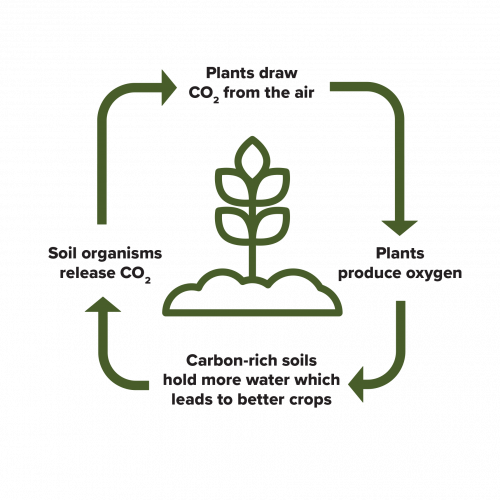For eons, Earth has evolved to provide us the soil we have today. And for thousands of years, humans have benefited from most of what our soils have had to offer us. However, during the past few centuries, we have been destroying the very Earth we need to survive. While no one sets out to destroy that which provides for us, we don’t necessarily understand the damage we cause in producing the crops we need to survive. Much of the damage actually occurs as we attempt to enhance the soil in order to produce more and support our agricultural communities. For instance, the Dust Bowl was a time of severe storms during the early twentieth century that changed the way Americans lived, and resulted in many moving from the rural areas into the cities. Most of us aren’t old enough to remember the Dust Bowl; we at IND HEMP certainly don’t remember it, but we remember our families telling us about it. Our Grandpa McCool grew up in Beaver, Oklahoma—the epicenter of the Dust Bowl—and told stories of having to crawl on the ground to stay on the path as he returned home from school.
Many blame the severe drought for the dust storms, but it was much more than just a lack of rain. Much of the fault lies with poor land management and farming practices. The grasslands of the Great Plains, mostly used for grazing stock, were plowed under to plant more wheat and other grain crops. Because of low crop prices, farmers would till more of the soil to plant more acres in hopes of being able to provide for their families. With a limited understanding of what they were doing to the soil, the harder they worked and the more acres they tilled compounded the very problems they were trying to solve. They wanted more from the soil, so they could feed more of the people who depended on them, but the good soil had blown away—what was left was unable to sustain them. In his epic film The Dust Bowl, Ken Burns describes the time when the rains stopped and the winds began to blow, as “the greatest man-made ecological disaster in the history of the United States.”
At the end of World War II, soldiers came home; many went back to their farms, their loved ones, and the lives they left behind. The world was shattered from war and looked to the United States to help rebuild and feed those who could not feed themselves. In order to produce more to feed a growing nation and a hungry world, farmers increased their yields through chemicals. Herbicides and pesticides were pumped out of chemical factories at a rate that had never been seen before. Tons of toxic chemicals were poured onto family farms to produce more by eliminating bugs and weeds to the point of sterilizing the very ecosystems that provided for the crops in the first place.
Do our farmers now, or did our farmers then set out to destroy the very soil that sustains us? Of course not. Farmers have always been the conscientious custodians of our land and have represented the best of America. They work hard for their families and their communities. They care for the family farms that have been entrusted to them, and they feed the world—a world that includes you and me.
Regenerative farming practices restore the soil’s ecosystem. When we reduce the use of pesticides, we allow worms, bugs, fungi, and bacteria to grow—even flourish—in our soils. By reducing or eliminating the amount of tilling we do to our soils, we reduce water runoff and erosion and increase the amount of moisture that soaks into the ground.
More water soaking into the ground means more life underground, and that’s a great thing. When we have a healthy soil ecosystem, the plants above the surface thrive, drawing carbon dioxide out of the atmosphere and down into the ground where it can be used and stored.
In her paper “Soil as Carbon Storehouse: New Weapon in Climate Fight?” (Yale School of the Environment) Judith D. Schwartz asserts, “Carbon is the main component of soil organic matter and helps give soil its water-retention capacity, its structure, and its fertility.” Better soil means healthier plants; healthier plants draw more carbon dioxide into the soil; more carbon dioxide in the soil means more fertile soil; more fertile soil means healthier plants. Can you see where this is going?
Regenerative farming involves implementing farm practices that lead to healthier soil. Soil health is measured by many parameters including organic matter, biodiversity, water infiltration, nutrient balance, and biosequestration. Many conventional farming practices lead to imbalanced soil with poor fertility, whereas regenerative farming leads to long-term environmentally and economically sustainable soil productivity.
Reduce tilling, harsh chemical application, fertilizer misuse and other practices that disturb the soil’s ecosysytem.

Include many different crops to break disease cycles and increase soil biodiversity
Year-round crops with no-till practices offers soil increased moisture and carbon retention, plus better cover & structure.

A living root year-round will lead to improved soil aggregation, organic matter as well as water infiltration.

Integrating livestock into fields that are not being harvested helps with soil nutrients, biodiversity, and no-till management.
In recent times, many have realized that soil is much more than just dirt, and that we must learn more about it to benefit more from it. In fact, Leonardo Da Vinci wrote in the 16th century, “We know more about the movement of celestial bodies than about the soil underfoot.” Now, in the 21st century, our interest in the soil is beginning anew. We now recognize that there is a vital ecosystem living in the soil just beneath our feet and a movement is underway to try to repair what has been damaged over the past hundred years or so.
Within our soil are commonly recognized organisms, but there are also bacteria and fungi that are very active and working together to build and maintain a healthy ecosystem. Undisturbed, this ecosystem creates extremely fertile soil; it’s when we interrupt the natural process that we cause the soil to degrade and the organisms to die off. There simply is not enough room here to try to explain how nature takes care of itself; in fact, whole branches of science are devoted to studying this process. Suffice to say, we must figure out a way to return our soil ecosystem to its natural state. In addition to helping the farmer grow more crops, this underground ecosystem is vital to the future of our planet.
Our carbon footprint is the topic of many books, news articles, and symposia. Authors ranging from devoted scientists to environmental activists all seem to have something to say on the subject. So, what is our carbon footprint?
Our carbon footprint is commonly understood as the amount of greenhouse gases we collectively or individually generate and/or emit into our atmosphere as a result of the consumption or use of fossil fuels. That is, when we burn fossil fuels, carbon compounds (carbon dioxide, carbon monoxide, methane gas, etc.) are emitted into the atmosphere.
In the atmosphere, those carbon gases, as well as other greenhouse gases, trap heat and increase the temperature in the earth’s atmosphere. According to the U.S. Environmental Protection Agency, carbon dioxide makes up over 80% of the greenhouse gases in our atmosphere, which brings us to how the future of our planet may be dependent on the underground ecosystem.
Our soil ecosystem, anchored by healthy plant life at the surface, draws the carbon dioxide (greenhouse gases) out of the atmosphere and sequesters it below the surface. Our soil can hold more carbon than our atmosphere and plants combined! Obviously, without healthy soil to sustain a vibrant plant cover, the carbon absorption capacity is greatly diminished. Some experts believe we have lost between one-third to one-half of our topsoil over the past 150 years, and the United Nations predicts we could lose the remaining topsoil over the next 60 years. That’s only 60 more harvests until the soil we know is no longer with us!
If we change our farming practices now, we can start to repair the damage we have already caused and begin to restore our soil ecosystem and, by extension, our atmosphere, we can create a world that is healthier and more sustainable. With regenerative farming practices creating soil ecosystems that pull greenhouse gases from our atmosphere, we can look forward to reducing our carbon footprint and global climate change. We will reach carbon neutrality when we get to the point where we are sequestering as much carbon in our soil as we are emitting into our environment through our consumption of fossil fuels. Imagine a day when we care for our soil ecosystem to the point that it starts caring for us, sequestering more carbon than we’re producing. Global climate change will start to turn around and life on earth will get better for everyone.

IND HEMP recognizes the commitment of our farmers who are raising industrial hemp for us and fully support and encourage regenerative farming practices. Our farming management program is run by our agronomist Ben Brimlow who explains:
When IND HEMP partners with local Montana growers in raising hemp for grain and fiber, we take regenerative farming up a notch!
Raising industrial hemp provides our farmers the opportunity to use a new rotational crop that thrives using regenerative farming practices. Hemp farming reduces the dependency on synthetic chemicals, provides a habitat for beneficial organisms, increases overall ecological biodiversity, improves soil structure, maximizes water use efficiency, and sequesters atmospheric carbon with the harvest of both grain for food and the stalks for industrial applications. With the addition of industrial hemp into a crop rotation, growers can expect to see real improvement in their soil health, their surrounding environment, and their farm productivity.
IND HEMP is structured as a Public Benefits Corporation (B Corp) with the intent of making a difference within our community and improving the environment. Our company’s mission is to provide innovative agricultural products and services to connect American farmers with the pioneers and businesses that see hemp as a way to bring real and lasting change to our communities and planet.
IND HEMP believes that in addition to its nutritious grain, healthy oils, and versatile fiber and hurd, the hemp plant can be used to help repair the world and make it a better place for everyone. President Franklin D. Roosevelt said in a letter to all state governors in 1937 that “The Nation that destroys its soil destroys itself.” If that is true, is it possible that the nation the saves its soils saves itself?
Our President Ken Elliott explains, “IND HEMP recognizes the need for more sustainable resources and better farming practices. When I started in hemp one of my goals was to help educate farmers on the benefits of this plant, and since then I’ve learned that hemp is far more versatile and eco-friendly than I could have imagined just a few years ago. Now, with the help of our farmers and industry friends, we are trying to make a difference in repairing the damage to our soil ecosystems. Working with such a great crop and utilizing regenerative farming practices, Montana is well-positioned to lead the next generation of farmers who will change the way this world does business.”
We would love to hear from you! Just call, email or use the button here to connect with us. Our mission is to connect our farmers with the hemp businesses of tomorrow. Let us provide the supply chain consistencies your business or product needs to scale and be successful.
Growers: to discuss what hemp production on your Montana, Idaho, Washington, or Oregon farm can do for you, visit here.
Want to be part of IND HEMP? Check our career opportunities here!